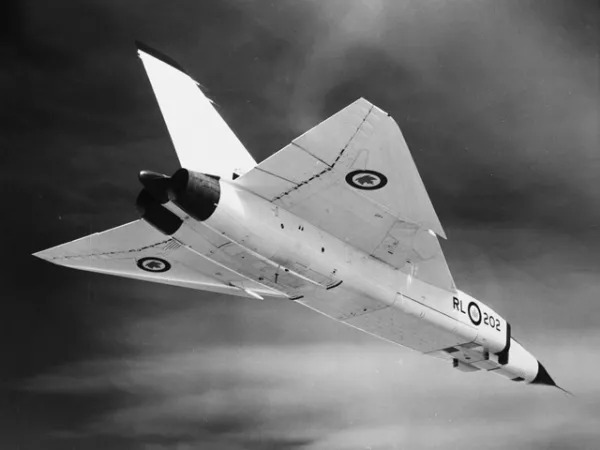Six a long time after the supersonic Avro Arrow all of the sudden stopped flying, Canada is working onerous to protect what few items of it are left.
The Avro Canada CF-105 Arrow (generally known as the Arrow amongst its followers) was some of the superior supersonic jets of its period within the Nineteen Fifties. It even has a hyperlink with NASA throughout the border, in keeping with the Canadian Encyclopedia. However the Arrow program’s funding was nixed in 1959 in a still-controversial determination by the Canadian authorities of the day, led by Prime Minister John Diefenbaker.
There was a silver lining for NASA, as just a few of Avro’s workers finally have been employed by the company and participated within the early U.S. house program, in keeping with Ingenium. Some even labored on the Apollo moon landings. The Arrow’s legacy was just lately celebrated at a Canadian museum attempting to maintain protected the few components that stay from this system, because the airplanes, plans and most different artifacts have been destroyed within the aftermath of the cancellation determination.
Fortunately, there’s an Arrow nostril part on show in Ottawa that represents the biggest surviving piece of any of the airplanes; it is within the Chilly Warfare part of the Canada Aviation and House Museum (CASM). Ingenium, which is the group made up of CASM and two different Ottawa museums, just lately took a take a look at the nostril piece to see the way it was doing.
Associated: In images: Chuck Yeager: 1st individual to interrupt the sound barrier
After museum officers seen flaking paint, they referred to as in representatives from the federal government’s Canadian Conservation Institute (CCI), because the institute works with authorities heritage collections. At CASM, the institute instructed the general public on Sept. 5 how they really feel the artifact is holding up after a long time in storage or on show.
To be clear, there are different items of the Arrow nonetheless preserved, however only some; many of the airplane items have been reduce up for scrap whereas “blueprints, fashions, designs and machines used to make the planes have been destroyed,” the Canadian Encyclopedia wrote. This example makes the nostril cone all of the extra valuable, as there are scarce remnants of the Arrow’s existence nonetheless with us six a long time on.

CCI representatives did non-invasive examinations with strategies similar to X-rays, and took just a few tiny samples, to test on the nostril cone’s well being. The evaluation uncovered new clues about how the airplane was made. For instance, at the least one a part of the aircraft’s exterior was made from an aluminum alloy, doubtless together with parts similar to copper, iron and manganese.
The hatch door of the nostril piece had some naked steel and yellow-brown “materials” that additionally underwent scrutiny. The evaluation confirmed the Arrow was handled with zinc chromium earlier than flying, to stop corrosion when flying by means of the air. “These supplies are identified to truly ‘brown’ as they discolor or degrade,” Kathleen Sullivan, CCI conservator of archaeological supplies, instructed the viewers throughout the Sept. 5 occasion.
Degrading, cream-colored paint on the plane in addition to a greasy-looking substance on the radar dome additionally have been scrutinized. The radar dome is comprised of chloroprene rubber, much like what wetsuits require; that rubber is “changing into virtually spongy” with age, CCI conservation scientist Jennifer Poulin mentioned. The grease can also be because of age; it is from non-toxic silicone “migrating out from contained in the rubber to the floor.”

The brand new evaluation will permit conservators to raised implement methods within the coming years to maintain the Arrow items, which additionally embody ejection seats and flight fashions, preserved within the coming a long time. The Arrow is a well-liked exhibit on the museum, as its loss stays a sore level within the Canadian aviation group.
Debate continues about whether or not the federal government made the proper selection given the excessive price and rapidly altering expertise of the period.
“Some assume that the Arrow’s excessive prices contributed to its downfall,” the Canadian Encyclopedia said; this system was estimated at $1.1 billion CDN in 1959, which interprets to roughly $11.65 billion CDN right now, or $8.57 billion USD at present alternate charges. (For perspective, Canada’s 2024 federal finances anticipated $449.2 billion CDN in spending.)
“The Arrow program was very costly for a rustic of Canada’s dimension,” the encyclopedia added. “However its expertise was one other concern. The [Canadian] Military’s chief of the overall employees, Lieutenant-Common Man Simonds, was amongst those that thought that it was already outdated.”
Different international locations, together with america, have been catching up and surpassing the Arrow’s supersonic expertise, the encyclopedia famous. Additionally, satellites have been beginning to enter orbit as of 1957, throwing into doubt the Arrow’s major function in protection, because it was designed to cope with intercontinental ballistic missiles originating from Earth.





